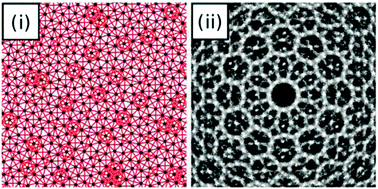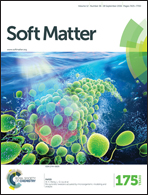Molecular dynamics study of colloidal quasicrystals
Abstract
Colloidal quasicrystals have received increased interest recently due to new insight in exploring their potential for photonic materials as well as for optical devices [Vardeny et al., Nat. Photonics, 2013, 7, 177]. Colloidal quasicrystals in aqueous solutions have been found in systems of micelles with impenetrable cores [Fischer et al., Proc. Natl. Acad. Sci. U. S. A., 2011, 108, 1810]. A simple model potential for micelle-micelle interaction is the step potential, which is infinite for core overlaps and constant for shell overlaps. Dotera et al. performed Monte Carlo simulations of the step potential model and found quasicrystals for specific values of the packing fraction η and the shell–core ratio λ [Dotera et al., Nature, 2014, 506, 208 ]. However, the overlap of real micelles causes repulsive forces, which increase with decreasing core distance. We consider this by introducing a novel model potential with repulsive forces depending on a third parameter α. In a systematic manner we study this more realistic potential with two-dimensional molecular dynamics simulations. For α = 0 the model is similar to the step potential model. For the first time, we provide a comprehensive overview of crystalline, quasicrystalline, and disordered structures as a function of η and λ. Simulations performed with α > 0 show the impact of the repulsive forces. We find that quasicrystalline structures at high densities vanish while new quasicrystalline structures appear at intermediate densities. Our results help to tailor colloidal systems for today's advanced applications in photonics and optical devices.


 Please wait while we load your content...
Please wait while we load your content...